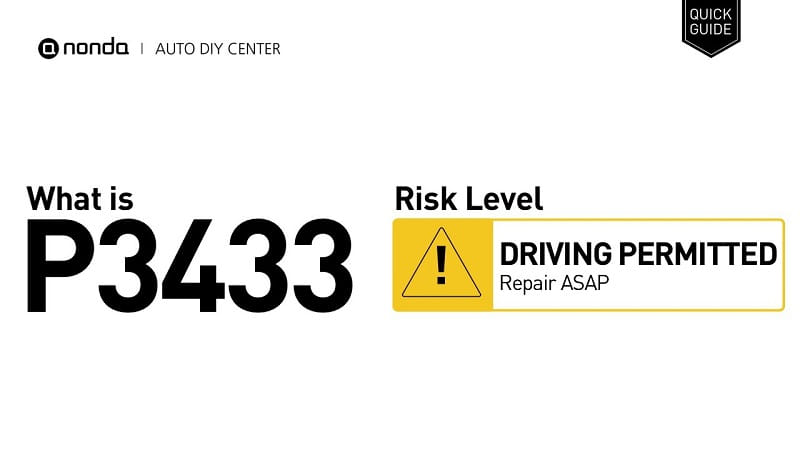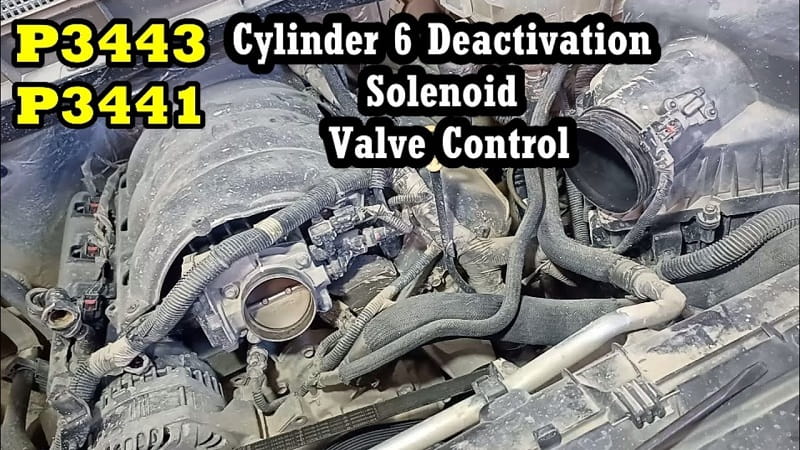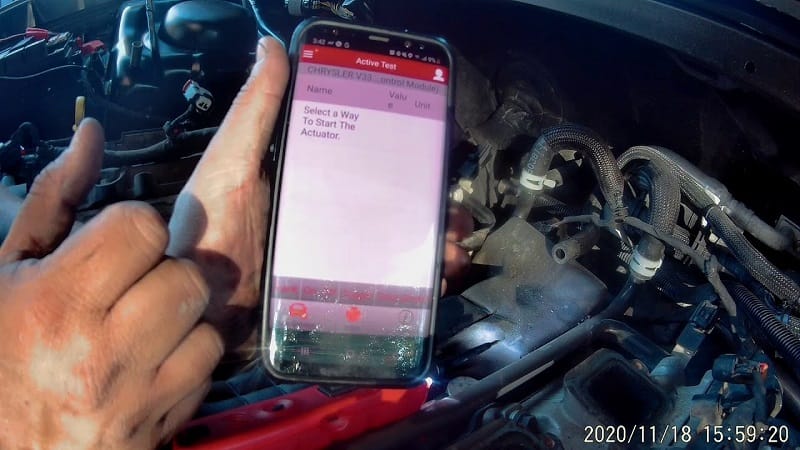This post contains affiliate links. This means I will make a commission at no extra cost to you should you click through and make a purchase [ “As an Amazon Associate, I earn from qualifying purchases.” ]. Read the full disclosure here.
Understanding Diagnostic Trouble Code P3433: Cylinder 5 Deactivation/Intake Valve Control Circuit/Open
Introduction GuideMechanic.Com As automotive technology advances, modern engines increasingly rely on sophisticated control systems to optimize performance, fuel economy, and emissions.
One such system is cylinder deactivation, which selectively disables cylinders during low-load conditions to save fuel. This functionality depends heavily on precise control of intake and exhaust valves.
Diagnostic Trouble Code (DTC) P3433 relates specifically to an electrical fault in the Cylinder 5 Deactivation/Intake Valve Control Circuit. The “Open” designation indicates that the Engine Control Module (ECM) has detected an open circuit or break in the wiring or components responsible for controlling the intake valve deactivation on cylinder 5.
This article provides an in-depth exploration of DTC P3433, covering its meaning, causes, symptoms, diagnosis, and repair strategies, providing useful insight for both automotive professionals and vehicle owners.
See Also: P3434 Cylinder 5 Deactivation/Intake Valve Control Circuit Performance
P3433 Cylinder 5 Deactivation/Intake Valve Control Circuit/Open
What Does DTC P3433 Mean?

DTC P3433 is defined as “Cylinder 5 Deactivation/Intake Valve Control Circuit/Open.”
This code indicates that the ECM is not receiving the expected electrical signal from the intake valve control solenoid or actuator for cylinder 5 due to an open circuit.
An open circuit means there is a break or disconnection somewhere in the wiring harness, connector, or the solenoid itself.
Since the intake valve deactivation solenoid plays a critical role in enabling or disabling the intake valve operation for cylinder 5, an open circuit disrupts proper cylinder deactivation, impacting engine efficiency.
How the Cylinder Deactivation Intake Valve Control Circuit Works
Cylinder deactivation systems work by deactivating valve operation on selected cylinders during low load or cruising conditions. This reduces fuel consumption and emissions.
The intake valve control solenoid receives an electrical signal from the ECM to either activate or deactivate the intake valve lifter mechanism on the specific cylinder. The solenoid regulates oil pressure, which mechanically locks or unlocks the intake valves.
The circuit controlling this solenoid includes:
- Power supply and ground wires
- Control wires for solenoid activation
- The solenoid actuator itself
When an open circuit is detected, the ECM cannot command the solenoid to function properly.
P3433 Cylinder 5 Deactivation/Intake Valve Control Circuit/Open
Symptoms of DTC P3433

When the Cylinder 5 Intake Valve Control Circuit is open, various symptoms may appear, including:
- Check Engine Light (CEL) or Malfunction Indicator Lamp (MIL) is illuminated
- Engine may run rough or exhibit misfire symptoms
- Loss of cylinder deactivation function in cylinder 5, leading to reduced fuel efficiency
- Engine hesitation or poor acceleration
- Increased emissions
- Unusual noises from the valve train or cylinder 5 area
These symptoms may vary depending on engine load and operating conditions.
Common Causes of P3433
The primary cause of P3433 is an open electrical circuit in the intake valve control wiring or components for cylinder 5. Specific causes include:
1. Damaged Wiring Harness
The wiring harness running to the intake valve solenoid on cylinder 5 may be cut, frayed, or pinched, causing an open circuit.
2. Corroded or Loose Connectors
Corrosion or poor connections at the solenoid connector or ECM connector can result in an intermittent or permanent open circuit.
3. Faulty Intake Valve Control Solenoid
An internally failed solenoid or broken internal wiring can cause an open circuit condition.
4. Faulty ECM or Powertrain Control Module (PCM)
Though less common, a damaged ECM driver circuit for the solenoid may produce an open circuit reading.
5. Physical Damage from Engine Heat or Vibration
Over time, exposure to heat, vibration, and engine contaminants can degrade wiring insulation or connectors.
P3433 Cylinder 5 Deactivation/Intake Valve Control Circuit/Open
Diagnosing P3433
Accurate diagnosis is essential to fix DTC P3433 properly. Follow these steps:
Step 1: Retrieve and Confirm Trouble Codes
Use an OBD-II scanner to confirm P3433 and check for related codes.
Note if any other cylinder deactivation or valve control codes exist.
Step 2: Visual Inspection
Inspect the wiring harness and connectors for cylinder 5 intake valve control solenoid.
Look for damaged wires, broken insulation, corrosion, or loose connectors.
Step 3: Check Wiring Continuity
Using a multimeter, test continuity between the solenoid connector and the ECM terminals.
A break or open reading confirms wiring damage.
Step 4: Test the Intake Valve Control Solenoid
Disconnect the solenoid and check its resistance with an ohmmeter.
Resistance readings significantly out of manufacturer specification suggest solenoid failure.
Step 5: Inspect Grounds and Power Supply
Confirm proper power supply and ground at the solenoid connector using a multimeter.
Low or no voltage indicates wiring or fuse issues.
Step 6: ECM Output Check
With a scan tool capable of bi-directional controls, command the solenoid ON and OFF.
Monitor voltage changes to verify ECM functionality.
P3433 Cylinder 5 Deactivation/Intake Valve Control Circuit/Open
Repair Options for P3433

Based on diagnosis, perform appropriate repairs:
1. Repair or Replace Wiring Harness
Fix any damaged wiring by cutting out damaged sections and soldering in new wire.
Replace connectors if corroded or damaged.
2. Replace the Intake Valve Control Solenoid
If the solenoid tests faulty, replace it with a new, OEM-grade part.
3. Restore Power and Ground Connections
Clean, tighten, or repair power and ground connections to ensure proper voltage supply.
4. ECM Repair or Replacement
If ECM output circuitry is defective, consult professionals for ECM repair or replacement.
Can You Drive with P3433?
Driving with DTC P3433 is possible but not advisable:
- Loss of intake valve deactivation on cylinder 5 will reduce fuel economy.
- Engine performance may degrade with rough idle or hesitation.
- Increased emissions could lead to failed inspections.
- Prolonged operation may stress other engine components.
- Timely repair is recommended to avoid further damage and restore optimal engine operation.
Preventive Maintenance Tips
To reduce the chances of DTC P3433:
- Regularly inspect wiring harnesses and connectors during maintenance.
- Replace engine oil on schedule to prevent sludge buildup that can affect solenoid operation.
- Avoid rough handling or modifications to the engine wiring.
- Use quality replacement parts from reputable suppliers.
- Address any electrical issues promptly to prevent circuit damage.
Conclusion
Diagnostic Trouble Code P3433: Cylinder 5 Deactivation/Intake Valve Control Circuit/Open is a clear indication of an electrical open circuit fault affecting the intake valve control solenoid for cylinder 5.
This fault disrupts proper valve operation and cylinder deactivation, leading to decreased fuel economy, engine performance issues, and increased emissions.
With systematic diagnostic procedures—inspecting wiring, connectors, solenoid function, and ECM output—the root cause can be identified and corrected.
Whether through wiring repair, solenoid replacement, or ECM service, resolving P3433 is essential for maintaining the health and efficiency of modern engines.
If you face P3433, consider professional diagnostics or repair to ensure the issue is addressed comprehensively.
- Custom Lifted Diesel Trucks for Sale - December 20, 2025
- New Lifted Diesel Trucks for Sale - December 19, 2025
- Old Lifted Diesel Trucks for Sale - December 18, 2025
